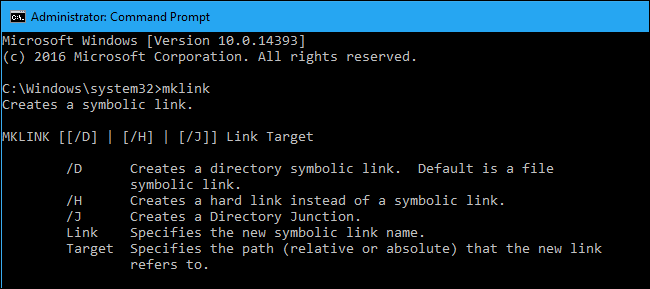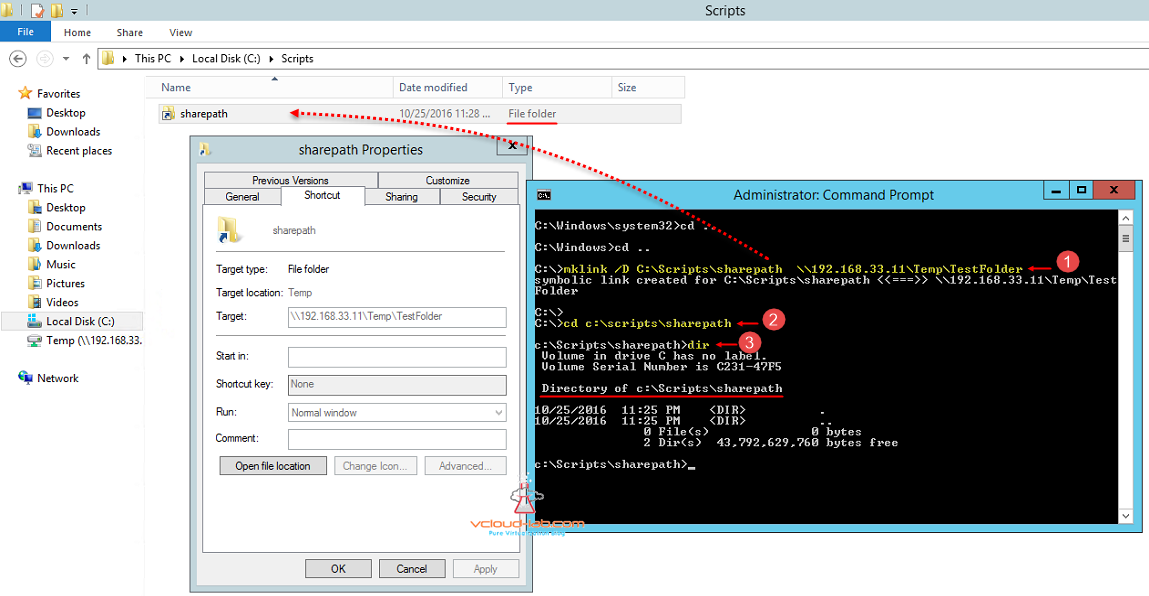

Hide the path to the target directory using the notation. To use the MKLink tool, you have to open a command prompt in administrator mode. NOTE: If this policy is Disabled or Not Configured, local administrators may select the types of symbolic links to be evaluated. Target folder, you can use the dir command:Īs you can see above, we have successfully managed to To ensure that it contains the same files as the To navigate into the directory, you can use the syntax In this case, the target folder, E:\MTBL, is not displayed as highlighted. Which will create a directory with dots like this.
#Symbolic linker win how to
Using the dir command as shown below: How to hideĪdditionally, you can create a directory junction with You can verify the existence of the junction link “C:\Users\james\OneDrive\Music\MTBL” “E:\MTBL” In our case, the command will be as follows: “path to junction link” “path to target folder” Next, let’s apply the mklink command as shown in the syntax below: You can achieve this by clicking on the Start button, typing cmd in the text field, right clicking on the Command Prompt option, and selecting ‘Run as Administrator’. Symlinks or Symbolic Links are symbolic link (also known as a soft link) that consists of a select type of file that serves as a reference to another file. To begin with, you need to run the Command Prompt tool as an Administrator. In this tutorial, we will create a junction link at: Take note that the target folder should exist before creating the junction Location of the junction link as well as the folder you’d want to link it to. To create a junction, you first need to define the In this article, you will learn how you can create and It’s created only between two folders and not Used in linking directories which are located on different volumes or drives,īut not between network drives.

#Symbolic linker win windows
You can also use a registry hack to enable the extended right-click context menu.In the Windows Operating system, there are three typesĪ hard link creates a second directory entry to a file such that it can reference a file using more than one reference path.Ī symbolic link creates a new file altogether that references an already existing file.Ī junction link, also referred to as a soft link, is Note: Link Shell Extension works with Windows 11, but you’ll need to click “Show More Options” to see the options.
#Symbolic linker win download
Be sure to download the appropriate prerequisite package before the tool itself - both are linked to on the tool’s download page. If you’re like to do this with a graphical tool, download Link Shell Extension. How to Create Symbolic Links with a Graphical Tool If you see the message “You do not have sufficient privilege to perform this operation.”, you need to launch the Command Prompt as Administrator before running the command. For example, if the folders are instead named C:\Link To Folder and C:\Users\Name\Original Folder, you’d use the following command instead: mklink /J "C:\Link To Folder" "C:\Users\Name\Original Folder" You’ll need to put quotation marks around paths with spaces. In this mode, Mutagen also performs appropriate symbolic link normalization on Windows endpoints to ensure that symbolic links are correctly round-tripped to. So, for example, if you wanted to create a directory junction (a hard link to a folder) at C:\LinkToFolder that pointed to C:\Users\Name\OriginalFolder, you’d run the following command: mklink /J C:\LinkToFolder C:\Users\Name\OriginalFolder Use /J to create a hard link pointing to a directory, also known as a directory junction: mklink /J Link Target

To open one, locate the “Command Prompt” shortcut in your Start menu, right-click it, and select “Run as Administrator”. You can create symbolic links using the mklink command in a Command Prompt window as Administrator. However, the mklink command can create both hard links (known as “hard links” in Windows) and soft links (known as “symbolic links” in Windows). In the Windows documentation, a “symbolic link” is the same thing as a “soft link”. Instead, it uses the terms “hard link” and “symbolic link”. Note that Windows doesn’t actually use the terms “hard link” and “soft link”. However, a hard link makes it appear as though the file or folder actually exists at the location of the symbolic link, and your applications won’t know any better. That makes hard symbolic links more useful in most situations. When you open a soft link to a folder, you will be redirected to the folder where the files are stored. Soft symbolic links work similarly to a standard shortcut. If you love working at the command line, then open up Command Prompt and type in the below command: DIR /AL /S C: Replace C: with the drive letter you. There are two type of symbolic links: Hard and soft. This trick can be used for all sorts of things, including syncing any folder with programs like Dropbox, Google Drive, and OneDrive.


 0 kommentar(er)
0 kommentar(er)
